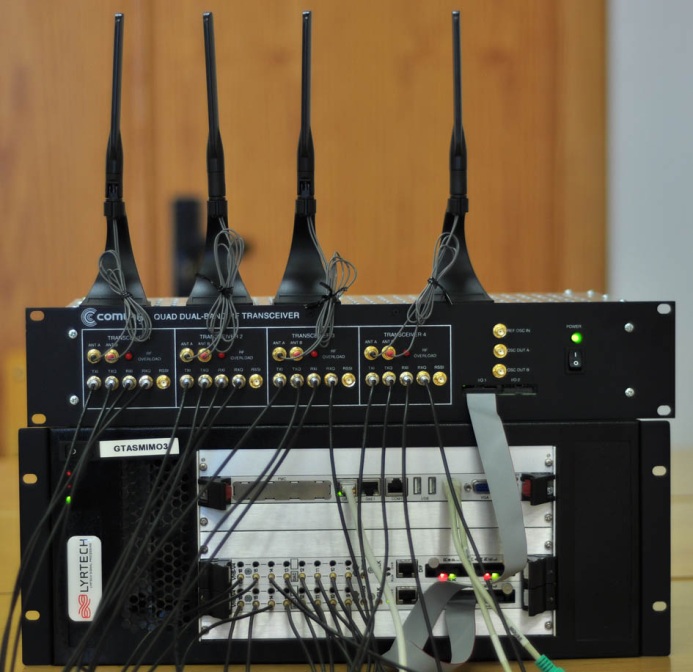GTAS MIMO testbed
|
The GTAS MIMO Testbed is an open access wireless network hardware demonstrator developed in the GTAS group at the University of Cantabria and conceived for the practical evaluation of multiuser multiantenna transmission techniques. The testbed consists of three transmit/receive nodes each equipped with Multiple Input Multiple Output (MIMO) capabilities. The testbed is suitable for assessing the performance of different transmission methods over wireless network channels, such as multiple access channels, broadcast channels, relay channels or interference channels. Obviously, it is also useful to evaluate transmission methods for point-to-point channels. |

|
Node description
Each testbed node consists of three main parts:
1. Radiofrequency front-end
The radiofrequency front-end (RFFE) is a Quad Dual-Band front-end from Lyrtech, Inc. with the following
characteristics:
- Up to eight antennas connected to four direct conversion transceivers
performing I/Q modulation/demodulation. - Based on Maxim MAX2829 chip (also found in frontends like Ettus XCVR2450
or Sundance SMT911). - Dual-band operation: 2.4 to 2.5 GHz and 4.9 to 5.875 GHz band.
- Up to 40 MHz bandwidth.
- Programmable variable attenuator to control the transmit power value up
to 25 dBm per transceiver. - Local oscillator synchronization is possible through a reference clock input.
2. Baseband boards
Each node is also equipped with two baseband boards, one for signal acquisition and the other one for signal playback. These are their chracteristics:
- VHS-DAC and VHS-ADC modules with eight DACs and eight ADCs.
- 8 x DACs: 14 bit @ 480 Msample/s.
- 8 x ADCs: 14 bit @ 105 Msample/s.
- Each pair of DAC/ADC is connected to a single transceiver of the RF front-end.
- The signals are passed in I/Q format.
- All channels can be externally triggered.
3. Control PC
The previously described hardware is connected to a personal computer. It is interfaced through a low-level API provided by Lyrtech, the hardware manufacturer. GTAS has encapsulated these basic functionalities into a modern API providing high-level local and remote access to the hardware. These remote control capabilities enable the realization of complex experiments where all three nodes are coordinated by a central PC which can control the whole process from anywhere on the Internet. Access to the testbed is offered in two different ways: using SOAP webservices or basic GET/POST HTTP requests.
How to use it
GTAS testbed nodes can be in three different statuses:
| Status | Description |
| OFFLINE |
Node is turned off (default status). If you want to use any of them, contact with some of the members of the group. |
| ONLINE [Not Available] |
Node is turned on but someone is using it. Additional information can be obtained by clicking in the node name. Only some functionalities are available, those which do not conflict with others' work. |
| ONLINE [Available] |
Node is turned on and available for you to use it. Additional information can be obtained by clicking in the node name. All functionalities are available. |
These are their current statuses:
- Node 1 OFFLINE
- Node 2 OFFLINE
- Node 3 OFFLINE
If you are familiar with web services, this is probably enough for you. However, you may also want to read our detailed documentation.
If you plan to use it in the near future, please book a free time slot.
Introductory examples & demos
- MATLAB Wrapper
- Example #1: Basic TX / RX (MATLAB Wrapper not included)
- Example #2: Step by step acquisition using HTTP GET methods
Additional usage examples
- MIMO Channel Characterization
- Performance evaluation of the MIMAX project idea vs. conventional 802.11a
- MIMO multiuser testbed developed in the framework of the COMONSENS project (joint work with the University of A Coruña)
- Basic TX/RX tests from Silverlight (developed by Uwe Mayer, Technische Universitaet Dresden)
- Building a Web Platform for Learning Advanced Digital Communications (ICASSP 2010 demo)

